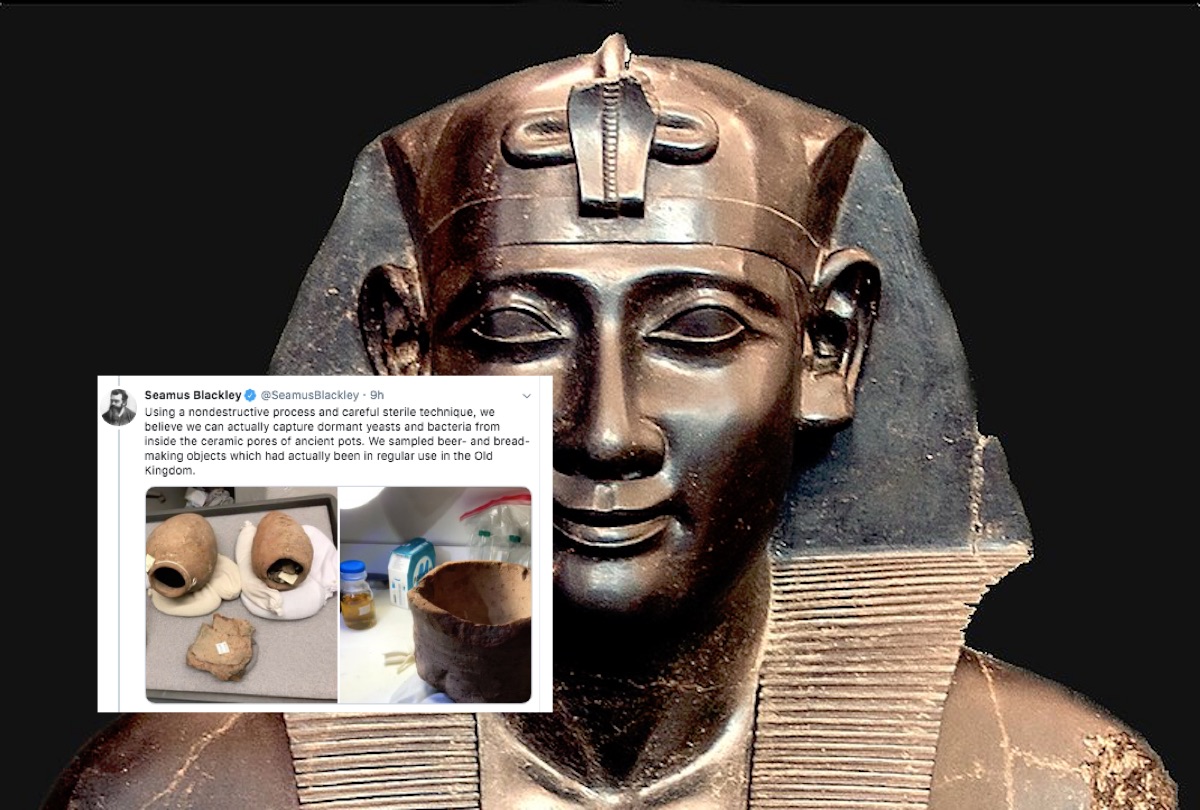Baking Bread with 4,500-Year-Old Ancient Egyptian Yeast Is a Pursuit We Can Appreciate

On Twitter, physicist (and “father of the X-Box”) Seamus Blackley shared his adventures in gastroegyptology, which is a thing I have just now learned about! Blackley recently worked with specialists in order to bake a rather unique bread fit for a Pharaoh, and it’s hard not gaze in wonder at what science hath wrought.
Blackley, a former video game designer and producer who was instrumental in the development of the X-Box at Microsoft, also calls himself an “amateur gastroegyptologist” in his Twitter bio. Along with Egyptologygist Dr. Serena Love and microbiologist Richard Bowman, Blackley & co. visited museums to harvest 4,500-year-old yeast samples from Ancient Egyptian vessels. Blackley’s subsequent raising of the organisms from the dead for doughy purposes is the ultimate combination of science-meets-whimsical curiosity, and I love it.
Bowman will analyze the samples to determine which “which microorganisms are old and which are modern contaminants,” so it’s not 100% clear yet what the team came back with. But that didn’t deter Blackley from cooking up a sample that he kept.
Two weeks ago, with the help of Egyptologist @drserenalove and Microbiologist @rbowman1234, I went to Boston’s MFA and @Harvard’s @peabodymuseum to attempt collecting 4,500 year old yeast from Ancient Egyptian pottery. Today, I baked with some of it… pic.twitter.com/143aKe6M3b
— Seamus Blackley (@SeamusBlackley) August 5, 2019
Using a nondestructive process and careful sterile technique, we believe we can actually capture dormant yeasts and bacteria from inside the ceramic pores of ancient pots. We sampled beer- and bread-making objects which had actually been in regular use in the Old Kingdom. pic.twitter.com/9FahMRjJBU
— Seamus Blackley (@SeamusBlackley) August 5, 2019
We took many samples and will continue to build our sample library over the next year or so. This is important as we need to learn which microorganisms are old and which are modern contaminants. Samples go to @rbowman1234 for rigorous analysis EXCEPT I was naughty and kept one… pic.twitter.com/cAIGmGcIJO
— Seamus Blackley (@SeamusBlackley) August 5, 2019
Using careful technique, UV sterilizers, autoclaved tools and containers, and sterilized, freshly milled Barley and Einkorn flour, I awoke and fed the sample organisms. Although this sample surely contains contaminants, it also likely contains actual ancient yeast strains. pic.twitter.com/hJQ8M2U2yS
— Seamus Blackley (@SeamusBlackley) August 5, 2019
Here is a large batch of starter, carefully made from the Old Kingdom sample, added to water and some unfiltered olive oil. The idea is to make a dough with identical ingredients to what the yeast ate 4,500 years ago. The aroma of this yeast is unlike anything I’ve experienced. pic.twitter.com/vf6QwKZmFi
— Seamus Blackley (@SeamusBlackley) August 5, 2019
This crazy ancient dough fermented and rose beautifully. Here it is in the basket, just before being turned out to bake. The ancient Egyptians didn’t bake like this- you’ll see- but I need to get a feel for all this so I’m going conventional for now. pic.twitter.com/lcGnOsaT9n
— Seamus Blackley (@SeamusBlackley) August 5, 2019
The results look frankly scrumptious.
And here is the result. The scoring is the Hieroglyph representing the “T” sound (Gardiner X1) which is a loaf of bread. The aroma is AMAZING and NEW. It’s much sweeter and more rich than the sourdough we are used to. It’s a big difference. After this cools we will taste! pic.twitter.com/sYCJ8uP1oj
— Seamus Blackley (@SeamusBlackley) August 5, 2019
The crumb is light and airy, especially for a 100% ancient grain loaf. The aroma and flavor are incredible. I’m emotional. It’s really different, and you can easily tell even if you’re not a bread nerd. This is incredibly exciting, and I’m so amazed that it worked. pic.twitter.com/qGRmi2Yg8Y
— Seamus Blackley (@SeamusBlackley) August 5, 2019
Finally, I need to say again, this was just for practice. @rbowman1234 needs to isolate and characterize the samples before we know for sure this is real. @drserenalove and I need to teach ourselves to actually bake like Egyptians. BUT ITS NOT A BAD START! Good Night! pic.twitter.com/ZkgeTqvloC
— Seamus Blackley (@SeamusBlackley) August 5, 2019
There are also practical applications to the experiment, including, as a Twitter user on Blackley’s thread points out, potentially low-gluten grains. As Blackley reminds, further analysis will be needed to know if they’ve isolated the ye olde yeasties they desire. Whatever Blackley did bake, however, sounds and looks uniquely tasty.
Yes. But first more work to be sure we have what I HOPE we have. Science.
— Seamus Blackley (@SeamusBlackley) August 5, 2019
Of course, people are already having fun with the subject matter in Blackley’s thread.
Is it rising?! pic.twitter.com/iU3zIZt17O
— Playmobil (Adjunct) Professor (@playmoadjprof) August 5, 2019
Just your standard awaking-ancient-egyptian-things activity. The Yummy Returns.
— Kristjan Rummel (@blu3ant) August 5, 2019
Until we hear more, we’ll remain cautiously optimistic—emphasis on cautious.
— Heather Wallace (@burntcopper) August 5, 2019
Do you have the tastebuds of an adventurer? Would you want to snack on ancient bread? While I’m not usually the boldest of eaters, I’d be ready to try this with a wedge of cheddar. The idea of biting into the past, and savoring flavors no one has known for millennia, has an exciting appeal that’s hard to resist.
(via Seamus Blackley on Twitter, image: Wikimedia Commons, Twitter)
Want more stories like this? Become a subscriber and support the site!
—The Mary Sue has a strict comment policy that forbids, but is not limited to, personal insults toward anyone, hate speech, and trolling.—
Have a tip we should know? tips@themarysue.com